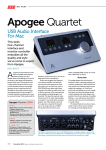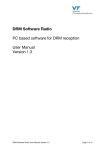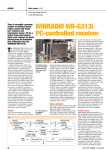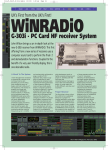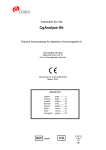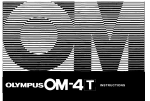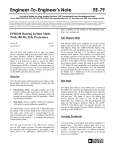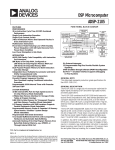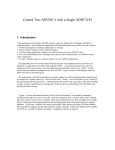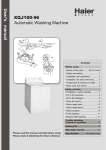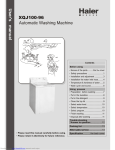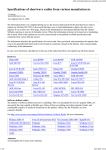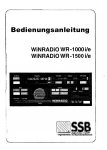Download WiNRADiO G313e HF Receiver
Transcript
F IRST LOOK CONSUMER RADIOS AND ELECTRONICS WiNRADiO’s G313e HF Receiver By Lee Reynolds, KD1SQ W iNRADiO (the brand/trading name of Rosetta Labs in Australia) are continuing to expand their well-received range of computer-controlled Software Defined Radio (SDR) offerings for HF reception. Starting with the entry-level internal PCI card G303i back in 2003, WiNRADiO went on to produce the entry-level external G303e in 2004, and the professionallevel internal PCI card G313i later that same year. All are excellent radios aimed at slightly different markets or user needs. WiNRADiO completed the line-up of radios in 2005 with the professional-level external G313e, thereby giving the customer a two tier choice in radios and setups for either in-PC use or external configuration. The G313e is WiNRADiO’s external model of their top of the line G313i PCI card HF receiver. Covering 9 kHz through 30 MHz (an option is available for it that extends coverage to 180 MHz), the size of a thick paperback, the durably cased, USB-connected receiver is powered by a 12vdc power supply, which means that this receiver can be used with a desktop or laptop computer system at home, mobile, or in the field. Cosmetically almost identical to the lower-cost entry-level G303e (only differing in having ventilation slots in the case), the G313e is a product aimed at the commercial, governmental and high-end hobbyist market with its improved specifications, stability and abilities/tools. Out of the box, the G313e will receive all the conventional modes plus less conventional ones (synchronous AM, ISB, DSB) and is DRM-compatible. (Just add the WiNRADiO DRM plug-in, buy the license key, and it’s ready to go – no muss, no fuss.) 68 MONITORING TIMES May 2006 Additional software packages can add reception of various digital modes, more sophisticated audio processing, frequency database management, and network/internet based client/server control of the radio. Free plug-ins for the radio are also available that add interesting new capabilities to the device, such as 3D spectrum waterfall displays, Receiver type Frequency range Tuning resolution Mode Image Rejection IP3 Spurious-free dynamic range MDS Phase noise Internal spurious RSSI accuracy RSSI sensitivity Bandwidth Scanning speed DSP-based SDR with DDS-based dualconversion superheterodyne front end 9 kHz - 30 MHz (optionally 9 kHz - 180 MHz) 1 Hz AM, AMS, LSB, USB, DSB, ISB, CW, FM 1.8-7.3 MHz: 80 dB 7.3-30 MHz: 70 dB +8 dBm @ 20kHz 95 dB -135 dBm -148 dBc/Hz @ 100 kHz Less than equivalent antenna input of -115 dBm 2 dB -137 dBm 50 - 15000 Hz (adjustable in 1 Hz steps) 400 steps/s (at 1kHz steps) different radio tuning tools, signal strength logging/display of a frequency over time, and channel occupancy over time. Specifications are good and, as is to be expected, the additional built-in IF DSP circuitry allows for improvement in performance; sensitivity, image rejection, phase noise and IP3 figures are all improved over those for the G303e. Readers who have the August 2005 MT with my ‘303e review in it might want to compare that article’s illustrations, receiver specifications and block diagram with the ones in this article. The G313e is definitely more complex than the G303e, and the difference between the control boards is an interesting illustration of how a little additional hardware can make a large difference in an SDR’s software capabilities. ❖ What’s in the box? The G313e package contains the following items: • The G313e itself • 120v *Linear* Power Supply (‘Linear’ is a nice touch – that means no nasty wall wart RF hash such as is common with ‘switched’ power supplies!) • USB cable • SMA-BNC adaptor • A simple ‘get started’ antenna • CD containing software • User’s manual How to install? Connection of the G313e to the computer is simple, the connectors and cables unambiguous. Connect the antenna to the SMA connector, either directly or via the needed SMA adaptor, attach the USB cable to the receiver, plug the other end into your computer’s USB port, plug in the power supply. Done! Software installation is simple and follows the pattern of any normal USB device. One recommendation – allow the installer to place the graphic user interface (GUI – the radio controls displayed on your screen) application in the default directory it suggests: If you’re anything like me you’re always messing with things, but I find that the WiNRADiO software (GUI App., plug-ins, etc.) is happiest in its suggested default location. ❖ How well does it work? As is to be expected, the G313e performs identically to the G313i. The graphic user interface is the same and the test bed CPU load for the external model stands at approximately 33% for a system with a 2.4 GHz Pentium-class CPU. The software, as usual, is very stable. (Most reports of software problems I’ve seen on the ‘net for this model appear to be caused by external factors, not by any deficiency in the WiNRADiO application code.) Using my standard test/comparison setup of an Alpha-Delta DX Ultra antenna feeding a Stridsberg multicoupler feeding the G313e, an ICOM R-75, ICOM R-8500 and a JRC NRD-525, I put the beast through its paces by digging around after various signals and modes of interest across its specified spectrum of coverage. Performance on LF/MF/ HF LF coverage was good, yielding excellent audio on weak beacons and utility stations. I did like the quality of reception up in the 120-520 kHz range and found the variable bandwidth filters and realtime spectrum display very useful in winkling out the weaker beacons. It does a creditable job across the rest of the LF band. On MF I puttered around in the AM band, maritime frequencies and Tropical band, seeking out interesting tidbits and problematic signals. Overload from strong AMers did not appear to be a problem; images were, as far as I could tell, nonexistent. Sensitivity was good; separating signals was easy, especially with the continuously variable bandwidth filters and passband tuning. HF testing showed similar characteristics. The steep skirts of the DSP-derived filters proved to be useful when copying densely packed digital signals such as BPSK in the amateur 14 MHz band around 14.070 MHz – you often find one or two huge signals in amongst them that’ll pump the receiver’s AGC, causing weak signals alongside them to disappear unless you have very good filter selectivity. This is also useful in the BC bands when you’re trying to pull NibiNibi out from under Deutsche Welle’s killer signal. Frequency stability and accuracy was excellent across the entire tuning range of the radio and excelled that of the G303e. There were no tasks I could set the device that the radio couldn’t perform. Audio – This is always a very subjective criterion. Give four SW listeners the same radio to test, ask how they liked the audio, and you’ll get four different answers. The G313e uses the controlling PC’s sound system for audio, so how good it can sound will depend on how good or bad your computer’s speakers are. I use good Logitech speaker/subwoofer setups on my test bed PC so I can easily hear if something’s not right. On a good AM/SW signal I could open the filters up to between 7 and 10 kHz bandwidth and get very clean-sounding audio from the rig. DRM is even better, and the limiting factor there appears to be the bandwidth of the encoded audio being transmitted. (It is a change to have something like that be the determining factor in how good a SW signal sounds… Of course, DRM is not a DX mode.) ❖ Features and Tools The G313e has a wide range of tools for studying and manipulating signals. It’s kind of interesting to consider that for a hobby which is intensely auditory in nature, visual tools add such a huge punch to what you can do with a signal. Apart from the realtime spectrum display of an up to 10 kHz wide segment of the band on either side of your tuned frequency, the G313e now sports two wideband spectrum displays: one for use with the conventional receiver GUI, the other a larger one that replaces the receiver GUI entirely. All the spectrum displays now have an improved resolution down to 16 Hz. Both Bandpass Tuning and IF Shift tuning are now available to the user, and tools exist for establishing the deviation of a received FM signal or depth of modulation of an AM signal. There’s the ability to easily record received audio but, more usefully, also the ability to record what amounts to 20 kHz of RF spectrum so that you can grab that weak signal and then play it back, trying out different combinations of receiver settings for best reception… Or you can record 20 kHz of closely packed digital signals and decode each one in turn at your leisure. S-meter accuracy has been improved (as a result of the additional built-in DSP circuitry mentioned below) and the S-meter still has more ways to be used and to display signal strength information than anything else I’ve seen. Lots of goodies, and all improved by the fact that they have easily understood graphical controls hung on ‘em. ❖ Judgment I give it first place amongst the four receivers. I believe that time and continued use of receivers of this class and type has given me an increased appreciation of such devices and I so vote accordingly. All performed creditably; there was no signal that the G313e May 2006 MONITORING TIMES 69 could hear that the NRD-525 couldn’t, but the “Swiss Knife toolkit” inherent in the G313e’s feature set for improving and/or analyzing those signals made it the winner. ❖ What’s inside it? As usual, I’m curious as to what’s inside devices like this, so I try to chase down as much information as I can as to the contents. One thing I’ve noticed with all the SDRs I’ve encountered is that “less is more” as regards the apparent complexity of the device. Although the circuitry is vastly more complex than that of old-line receivers, the component count is usually smaller and the layout looks far less intimidating than, say, the guts of a Collins R-390. In keeping with WiNRADiO’s strategy of trying to design hardware that’s future-proof, a look inside the case of the G313e is an illustration of this thinking in action. What you see is a very close relative of the G303e that shares PCB design, much circuitry, and many components, yet is able to offer performance and abilities beyond those possible with the G303e. Overall case construction is very sturdy, PCB design is clean and layout/component complement is very similar to that of the G303e. A close look does reveal a few obvious differences, the biggest being an internal cooling fan installed on the 70 MONITORING TIMES May 2006 RF deck side of the case. Inquiry and a little live testing indicate that it’s more for peace of mind rather than a necessity. (It’s probably only really needed by the models used in confined spaces in humid, tropical environments in service of mysterious governmental customers.) The second noticeable difference is on the Control/IF board – You’ll see the fairly large DSP chip and associated components that perform similar functions to those provided externally by your sound card for the ‘303e model. The DSP chip used to replace your PC’s sound card is an ADSP2185 manufactured by Analog Devices. This chip helps give the G313e better dynamic range, higher signal sampling rates, and improved spectrum display resolution, among other things, than is possible with an ordinary sound card. (If you have the G303e review available to you, you’ll notice that the PCB is silkscreened for the devices that exist on the G313e. Logically extrapolating, I asked about the remaining empty spots on the G313e PCB but I’m given to understand that if WiNRADiO told me what goes there for some customers, they’d then have to kill me. Apparently it’s not for future consumer use!) The block diagram for the receiver is included here to provide a coarse overview of the design of the device. The ADC and DSP components appearing at the bottom of it are specific to the G313e’s diagram and represent the built-in “sound card” functionality of this model. ❖ Summary Out of all of the HF radios I’ve owned over the years, if I had to choose only one, I think that I’d have to select the G313 in either its internal or external incarnation. I am still a fan of the old style standalone non-SDR radio – like most of you I grew up with radios with knobs and dials and I’m still a little more comfortable with them under many circumstances. A lifetime’s tuning habits don’t die easily. (Conversely, today’s kids find the concept of analog tuning devices to be ‘quaint’ at best. Remember when TVs had rotary tuning knobs? Not in the lifetime of most 25 to 30 year olds now.) That said, I still have to rate the G313i/e as the most flexible and fully featured radio I’ve encountered (or could afford) thus far. …It does too much, too well, and too flexibly to not be given the praise and credit that it deserves. If you want an all purpose radio that’s a good performer and is packed with useful features and tools that don’t exist in any other radio of its price class, this is the one to buy. The WR-G313e is $1,149.95 from Grove Enterprises (call 800-438-8155 or visit www. grove-ent.com)




